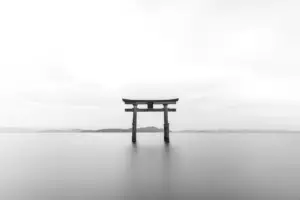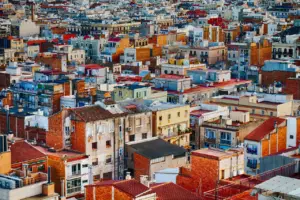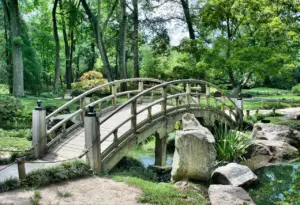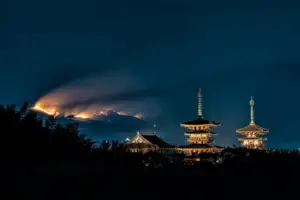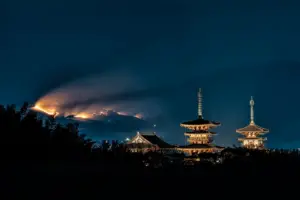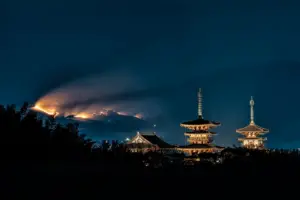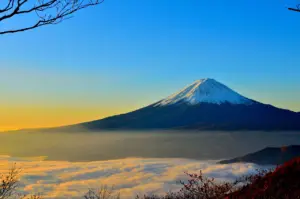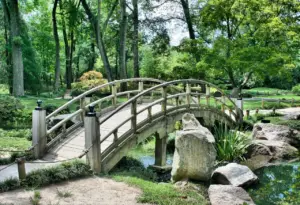Are you interested in exploring the spiritual and cultural heritage of Japan? If so, you are in for a treat as Japan is home to some of the most ancient and sacred places of worship in the world.
From the mystic mountains of Mount Koya to the ethereal beauty of the Itsukushima Shrine, Japan is a treasure trove of religious and spiritual landmarks.
In this article, we will take you on a journey to discover the 7 sacred places of worship in Japan. These sites have been revered and worshipped by generations of Japanese people for centuries and are a testament to the country’s rich cultural and religious heritage.
So, get ready to immerse yourself in the spiritual and mystical world of Japan, as we explore these sacred sites and their significance.
Key Takeaways
- Japan has 7 sacred places of worship, including the Ise Grand Shrine, Mount Koya, Itsukushima Shrine, and Todai-ji Temple.
- Kumano Kodo is an ancient pilgrimage route on the Kii Peninsula, consisting of three main routes: Nakahechi, Ohechi, and Kohechi.
- Visitors to these sacred sites must purify themselves before entering and the architecture is made entirely of wood using traditional techniques.
- Other notable sacred places of worship in Japan include Kiyomizu-dera Temple, Nikko Toshogu Shrine, Futarasan Shrine, and Yomeimon Gate.
Ise Grand Shrine
You’re going to love learning about the Ise Grand Shrine, one of the most sacred and revered places of worship in Japan! This shrine is dedicated to the Sun Goddess Amaterasu, who is believed to be the ancestor of the Japanese imperial family.
The Ise Grand Shrine is actually a complex of over 100 shrines, with the main shrine being rebuilt every 20 years in the same style and location as the original shrine, which has been done for over 1,300 years.
The shrine is located in the city of Ise in Mie Prefecture, and is surrounded by a beautiful forest. Visitors to the shrine are required to purify themselves before entering, which involves washing their hands and mouth at a nearby fountain.
The shrine is also known for its beautiful architecture, with the buildings made entirely of wood using traditional construction techniques. If you’re interested in Japanese culture and history, a visit to the Ise Grand Shrine is a must!
Mount Koya
Located in the misty mountains, Mount Koya is a truly awe-inspiring destination that will leave you feeling humbled and connected to the spiritual world. This sacred place of worship in Japan is home to over 100 temples and is considered the birthplace of Shingon Buddhism.
The serene and peaceful atmosphere of Mount Koya is perfect for those looking to escape the hustle and bustle of the modern world and connect with their inner selves. One of the most notable attractions on Mount Koya is Okunoin Cemetery, which is the largest cemetery in Japan and the final resting place of many prominent Japanese figures.
The cemetery is lined with over 200,000 tombstones and is surrounded by dense forest, creating a hauntingly beautiful atmosphere. Visitors can walk through the cemetery, pay their respects to the deceased, and even witness the famous lantern-lit path that leads to the mausoleum of Kobo Daishi, the founder of Shingon Buddhism.
A visit to Mount Koya is truly an unforgettable experience that will leave you with a newfound appreciation for the beauty and spirituality of Japan.
Itsukushima Shrine
When you visit Itsukushima Shrine, you’ll be amazed by the stunning beauty of the floating torii gate and the peaceful atmosphere of the surrounding island.
The shrine, also known as Miyajima Shrine, is located on the island of Miyajima, just a short ferry ride from Hiroshima. The torii gate, which stands in the water, is one of the most iconic images of Japan and is considered one of the Three Views of Japan.
The gate is built in a way that it appears to be floating during high tide, making it a breathtaking sight to behold. As you explore the shrine, you’ll notice the intricate details and craftsmanship that went into its construction.
The main hall of the shrine, which is designated as a National Treasure, was built in the 16th century and features a unique architectural style known as Shinden-zukuri. The shrine also has several other buildings, including a Noh stage and a prayer hall.
One interesting aspect of the shrine is that it was built on stilts to protect it from the tides and to allow visitors to approach it even during high tide. When you visit Itsukushima Shrine, you’ll not only witness the beauty of the shrine but also learn about the rich history and culture of Japan.
Todai-ji Temple
Get ready to be awestruck by the sheer size and grandeur of Todai-ji Temple, home to the largest bronze Buddha statue in the world! Located in Nara, this Buddhist temple was constructed in the 8th century and has since been rebuilt twice due to fires. The current structure, completed in 1709, is still massive – the main hall is an incredible 57 meters long and 50 meters wide!
As you approach the temple, you’ll be greeted by the Nandaimon Gate, which stands at 25 meters tall and is guarded by two fierce-looking statues. Once inside, you can marvel at the impressive Daibutsuden Hall, which houses the Great Buddha statue. The statue is over 15 meters tall and weighs a staggering 500 tons! As you stand in front of the statue, you’ll be humbled by its size and the incredible feat of engineering that went into creating it. As you take in the surroundings, you’ll notice the intricate details of the temple’s architecture, such as the ornate carvings on the pillars and the beautiful paintings on the ceilings. It’s truly a sight to behold!
| Emotion | Description | |||
|---|---|---|---|---|
| Awe | The sheer size and grandeur of the temple will leave you in awe. | |||
| Humility | Standing in front of the massive Buddha statue will make you feel small and humble. | |||
| Admiration | The detailed carvings and paintings on the temple are a testament to the skill of the craftsmen who built it. | |||
| Wonder | The incredible feat of engineering that went into creating the Great Buddha statue will leave you wondering how it was done. | Awe | Standing at the foot of a towering mountain, gazing up at its majestic peak, can fill you with a sense of awe and wonder. |
Kumano Kodo
If you’re looking for a unique and awe-inspiring adventure, you should definitely check out Kumano Kodo. This network of ancient pilgrimage trails is sure to take your breath away with its stunning scenery and historical significance.
For centuries, people have believed that Kumano Kodo is a sacred site, making it an ideal destination for those seeking a deeper spiritual experience.
A Network of Ancient Pilgrimage Trails
You’ll be amazed at the network of ancient pilgrimage trails in Japan, each one leading to a sacred place of worship and carrying with it the weight of centuries of tradition and spiritual significance. These trails, collectively known as the Kumano Kodo, are a UNESCO World Heritage Site and have been traveled by emperors, samurais, and commoners alike. The Kumano Kodo consists of three main routes, each with its own unique landmarks, rituals, and legends.
The Nakahechi route is the most popular and takes travelers through the heart of the Kii Mountains, passing by stunning waterfalls, ancient forests, and traditional villages. The Ohechi route follows the rugged coastline, offering breathtaking views of the Pacific Ocean and the opportunity to visit historic shrines and temples. Finally, the Kohechi route is the most challenging, taking hikers through steep mountain passes and remote valleys before reaching the sacred city of Kumano. No matter which route you choose, the Kumano Kodo is a journey that will leave you with a deep appreciation for the power of nature, the resilience of the human spirit, and the enduring importance of sacred pilgrimage in Japanese culture.
| Route | Highlights | Difficulty |
|---|---|---|
| Nakahechi | Waterfalls, forests, villages | Moderate |
| Ohechi | Coastal views, historic sites | Easy |
| Kohechi | Mountain passes, remote valleys, sacred city of Kumano | Difficult |
Known for Its Stunning Scenery
Experience the breathtaking beauty of the Kumano Kodo, where stunning scenery awaits you at every turn. This ancient pilgrimage route is known for its natural beauty, and it’s easy to see why.
As you walk the trail, you’ll be surrounded by lush forests, sparkling rivers, and towering waterfalls. The Kumano Kodo is a haven for nature lovers, and it’s a great place to escape the hustle and bustle of everyday life.
Here are just a few of the stunning sights you can expect to see on the Kumano Kodo:
-
The Nachi Falls: This breathtaking waterfall is one of the tallest in Japan, and it’s a must-see for anyone visiting the Kumano Kodo.
-
The Oyunohara: This ancient shrine is said to be the birthplace of Kumano, and it’s a fascinating place to explore.
-
The Tsugizakura-oji: This sacred tree is said to be over 800 years old, and it’s a popular spot for pilgrims to stop and rest.
The Kumano Kodo is a true treasure of Japan. It’s a great place to connect with nature and explore the country’s rich spiritual heritage. So why not lace up your hiking boots and experience the beauty of this ancient pilgrimage route for yourself?
Believed to be a Sacred Site
Immerse yourself in the mystical aura of the Kumano Kodo, believed by many to hold a profound spiritual power.
This ancient pilgrimage route, located on the Kii Peninsula, has been a sacred site for over a thousand years. The Kumano Kodo consists of a network of trails that lead to three grand shrines: Kumano Hongu Taisha, Kumano Nachi Taisha, and Kumano Hayatama Taisha. These shrines were built in honor of the deities believed to reside in the surrounding mountains and forests.
The Kumano Kodo is not just a physical journey, but also a spiritual one. As you walk along the trails, you will feel the power of nature and the divine. You will see the sacred trees, waterfalls, and rocks that have been revered by pilgrims for centuries. You will encounter small villages and temples that have been built along the way to serve the pilgrims.
The Kumano Kodo is a place where you can connect with the past and the present, and with your inner self. It’s a place where you can find peace, inspiration, and renewal.
Kiyomizu-dera Temple
If you’re interested in visiting a stunning Buddhist temple in Kyoto, you must see Kiyomizu-dera Temple.
This temple is known for its impressive architecture, which features a large wooden veranda overlooking a stunning scenery.
It’s also believed to be a place of miracles, making it a popular destination for those seeking spiritual healing or hoping to make a wish come true.
A Buddhist Temple in Kyoto
You’ll love visiting the Buddhist Temple in Kyoto, a stunning example of traditional Japanese architecture. As you approach the temple, you’ll be greeted by a beautiful garden filled with cherry blossom trees and a small pond that reflects the temple’s image.
Walking through the temple’s entrance, you’ll be amazed by the intricate designs that adorn the walls and roof. Once inside, you’ll be able to witness the daily rituals of the monks who reside in the temple. You’ll also have the chance to participate in meditation sessions and learn about the teachings of Buddhism.
If you’re lucky, you may even get to witness a traditional tea ceremony. Overall, the Buddhist Temple in Kyoto offers a unique and peaceful experience, allowing visitors to immerse themselves in Japanese culture and spirituality.
Known for Its Stunning Architecture
The stunning architecture of the Buddhist Temple in Kyoto will leave you in awe. Intricate designs adorn the walls and roof, creating a truly mesmerizing atmosphere. The temple is known for its unique and impressive style, which combines traditional Japanese elements with Chinese influence.
One of the most striking features of the temple is its roof, covered in ornate tiles and carvings. The intricate designs of the roof tiles represent various Buddhist deities and symbols and are a testament to the incredible skill of the craftsmen who created them.
The temple’s interior is just as impressive, with beautiful paintings and sculptures depicting scenes from Buddhist mythology. All in all, the Buddhist Temple in Kyoto is a must-see for anyone interested in Japanese culture and architecture.
Believed to be a Place of Miracles
Visitors to the Buddhist Temple in Kyoto may witness a miracle as it’s believed to be a site of supernatural occurrences.
This temple, officially known as the TÃ…Â-ji Temple, is home to a statue of Yakushi Nyorai, the Buddha of healing and medicine. Many people come to this temple seeking relief from physical and mental ailments, as it’s believed that the statue has the power to heal and grant wishes.
In addition to the Yakushi Nyorai statue, the temple also houses other sacred objects. These include a pagoda that’s said to have the power to ward off evil spirits and a bell that’s rung 108 times on New Year’s Eve to symbolize the release from worldly desires.
As you explore this sacred site, you may witness visitors praying, chanting, or performing other rituals in hopes of receiving a miracle. While the belief in supernatural occurrences may be unfamiliar to some, it’s important to respect the cultural and religious traditions of the temple and its visitors.
Nikko Toshogu Shrine
If you’re interested in exploring Shinto shrines in Japan, you might want to visit Nikko Toshogu Shrine. This shrine is known for its lavish decorations, intricate carvings, and beautiful architecture. It’s also dedicated to Tokugawa Ieyasu, the founder of the Tokugawa Shogunate, making it an important historical site to visit.
Adjusting the paragraph structure and using contractions will make the text easier to read and understand.
A Shinto Shrine in Nikko
Located in Nikko, there’s a Shinto Shrine that’s known for its stunning architecture and serene atmosphere. This shrine is called Futarasan Shrine, which literally means ‘two-mountain shrine.’
The name refers to the two sacred mountains that surround the shrine: Mount Nantai and Mount Nyoho. The Futarasan Shrine is one of the oldest shrines in Nikko, and it’s dedicated to the three deities of the mountains: Mount Nantai, Mount Nyoho, and Mount Taro.
The shrine was founded in the 8th century by a Buddhist monk named Shodo Shonin, who brought Shintoism to Nikko.
The Futarasan Shrine is a beautiful example of the traditional Shinto architecture. The shrine’s buildings are made of wood, with a distinctive black color that contrasts beautifully with the green surroundings.
The main building of the shrine is called Honden, and it’s where the deities are enshrined. The Honden is surrounded by other buildings, such as the Haiden (worship hall), the Kaguraden (music and dance hall), and the Chumon (gate).
The Futarasan Shrine is also known for its beautiful gardens, which are carefully designed to blend in with the natural landscape.
Visiting the Futarasan Shrine is a must-do for anyone who wants to experience the peacefulness and beauty of Nikko.
Known for Its Lavish Decorations
Now that you know about the Shinto Shrine in Nikko, let’s take a closer look at its lavish decorations. The shrine is known for its ornate carvings and intricate designs, which showcase the remarkable craftsmanship of Japanese artisans.
As you approach the shrine, you’ll notice the grandeur of its entrance gate, which is adorned with vivid colors and symbols that represent Shinto beliefs. Once you step inside the shrine, you’ll be awed by the exquisite details in every corner.
Here are three things you must see to truly appreciate the beauty of this sacred place:
-
The Yomeimon Gate: This gate is one of the most iconic symbols of Nikko and is often called the ‘Gate of the Sun.’ It’s decorated with over 500 carvings of dragons, lions, and other mythical creatures, each with its own unique expression and posture.
-
The Three Wise Monkeys: Known as ‘Mizaru, Kikazaru, and Iwazaru,’ these monkeys represent the principle of ‘see no evil, hear no evil, speak no evil.’ They are carved into the shrine’s gate and are a popular attraction among visitors.
-
The Main Hall: This hall is the central place of worship in the shrine and is where people come to pray and offer their respect. The hall is adorned with gold leaf and features a beautiful altar that is the focal point of the shrine.
Overall, the Shinto Shrine in Nikko is a testament to the rich cultural heritage of Japan and is a must-visit destination for anyone who appreciates art, history, and spirituality.
Dedicated to Tokugawa Ieyasu, the Founder of the Tokugawa Shogunate
Dedicated to Tokugawa Ieyasu, the founder of the Tokugawa Shogunate, visitors to the Shinto Shrine in Nikko can learn about the history of Japan and the powerful leader who played a significant role in shaping it.
The shrine, also known as the Toshogu Shrine, was built in the early 1600s, shortly after Ieyasu’s death, and is considered one of the most important and impressive shrines in Japan. It is adorned with intricate carvings, gold leaf, and colorful paint, all of which reflect the opulence and grandeur of the Tokugawa era.
Visitors can explore the numerous buildings and structures on the shrine’s expansive grounds, including the Yomeimon Gate, which is known as one of the most ornately decorated gates in Japan. The shrine also features a museum where visitors can view artifacts related to Ieyasu’s life and the Tokugawa Shogunate, as well as learn more about the history of Japan.
Overall, the Toshogu Shrine is a must-visit destination for anyone interested in Japanese history or architecture.
Frequently Asked Questions
Are there any specific rituals or customs that visitors should be aware of when visiting these sacred places?
When visiting sacred places of worship in Japan, there are certain rituals and customs that visitors should be aware of.
For example, it is common practice to bow before entering and leaving the temple or shrine as a sign of respect. You should also remove your shoes before entering the sacred space.
It is important to keep in mind that these places are considered holy and should be treated with reverence. Taking photos may be allowed in some areas but it is important to ask permission first and to avoid taking pictures of people praying.
It is also important to dress appropriately, covering your shoulders and knees. Finally, visitors should be mindful of their behavior and keep noise levels to a minimum, as many people come to these places to pray and meditate.
What is the significance of each of these sacred places in Japanese culture and religion?
Each of the sacred places in Japan holds significant religious and cultural importance. For example, the Itsukushima Shrine is believed to be the home of the goddess of the sea, and the Torii gate, which stands in the water, symbolizes the boundary between the human and spirit worlds.
The Kiyomizu-dera Temple has a long history and is known for its stunning architecture and breathtaking views of Kyoto. The Meiji Shrine is dedicated to Emperor Meiji, who played a vital role in modernizing Japan.
The Ise Grand Shrine is one of the oldest and most important Shinto shrines in Japan and is dedicated to the sun goddess Amaterasu. The Toshogu Shrine is a popular destination for visitors and is known for its intricate woodwork and vibrant colors.
The Senso-ji Temple is Tokyo’s oldest temple and is known for its massive lantern and bustling shopping street. The Golden Pavilion, otherwise known as Kinkaku-ji, is a Zen temple covered in gold leaf and is one of Kyoto’s most famous sights.
Each of these sacred places offers visitors a unique insight into Japanese culture and religion, making them a must-see when traveling to Japan.
How have these sacred places been impacted by natural disasters or human conflicts throughout history?
When it comes to the impact of natural disasters and human conflicts on sacred places of worship in Japan, it’s important to note that these sites have faced their fair share of challenges throughout history.
From earthquakes and typhoons to wars and invasions, many of these sacred locations have been damaged or destroyed at some point.
However, despite these setbacks, the people of Japan have always worked tirelessly to rebuild and preserve these important cultural and religious landmarks.
Whether it’s through reconstruction efforts or ongoing maintenance and restoration projects, the Japanese have shown an unwavering commitment to honoring and protecting their sacred places of worship, no matter what challenges may come their way.
Are there any famous legends or myths associated with these sacred places?
If you want to know whether there are any famous legends or myths associated with the sacred places of worship in Japan, the answer is yes.
These places have been the source of many stories and beliefs that have been passed down through generations.
For example, Mount Fuji, one of the sacred places, is said to be the dwelling place of the Kami, or gods. It’s also believed to hold the power to grant wishes to those who climb it.
Another example is the Itsukushima Shrine, which is built on the water and is known for its famous floating Torii gate. The shrine is said to be the home of the goddess Benzaiten, and the gate is believed to be a bridge between the spiritual and physical worlds.
These are just a couple of examples of the many legends and myths that surround the sacred places of worship in Japan.
Can visitors participate in any spiritual or religious activities at these sacred places, such as meditation or prayer?
Yes, visitors can participate in various spiritual and religious activities at these sacred places in Japan. Many of these places offer meditation sessions, prayer services, and other rituals for visitors to partake in. Some may require prior reservation or permission, while others may be open for anyone to join.
It’s important to respect the customs and traditions of each place and follow any guidelines or instructions given by the staff or clergy. Whether you’re seeking a deeper connection to spirituality or simply curious about the cultural significance of these places, participating in these activities can offer a meaningful and enriching experience.
Conclusion
So, there you have it, seven of the most sacred places of worship in Japan. Each of these sites holds a unique history and significance to the Japanese people, and offers visitors a chance to immerse themselves in the country’s rich cultural heritage.
Whether it’s the spiritual energy of Ise Grand Shrine, the peaceful tranquility of Mount Koya, or the awe-inspiring architecture of Todai-ji Temple, each of these locations offers a chance to connect with something greater than ourselves.
It’s important to remember that when visiting these sacred places, we should approach them with respect and reverence. These sites are not just tourist attractions, but hold deep meaning and significance to those who worship there.
By taking the time to learn about the history and traditions of these locations, we can deepen our understanding and appreciation for the rich tapestry of Japanese culture.
So, next time you’re in Japan, be sure to pay a visit to one of these sacred sites and experience the spiritual essence that permeates through these hallowed grounds.




































